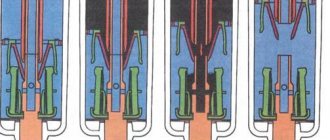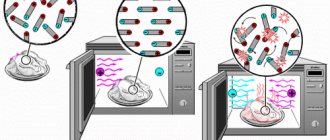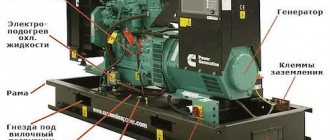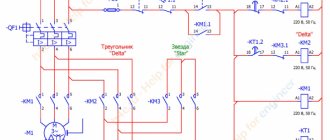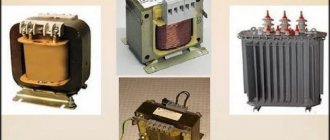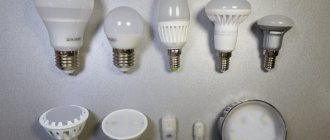In the second half of the 40s, before work was completed on creating the first atomic bomb, which was tested on August 29, 1949, Soviet scientists began developing the first projects for the peaceful use of atomic energy. The main focus of the projects was electricity.
In May 1950, near the village of Obninskoye, Kaluga Region, construction began on the world's first nuclear power plant.
Electricity was first produced using a nuclear reactor on December 20, 1951 in the state of Idaho in the USA.
To test its functionality, the generator was connected to four incandescent lamps, but I did not expect the lamps to light up.
From that moment on, humanity began to use the energy of a nuclear reactor to produce electricity.
First Nuclear Power Plants
The construction of the world's first nuclear power plant with a capacity of 5 MW was completed in 1954 and on June 27, 1954 it was launched, which is how the Obninsk NPP began to operate.
In 1958, the 1st stage of the Siberian Nuclear Power Plant with a capacity of 100 MW was put into operation.
Construction of the Beloyarsk industrial nuclear power plant also began in 1958. On April 26, 1964, the 1st stage generator supplied current to consumers.
In September 1964, the 1st unit of the Novovoronezh NPP with a capacity of 210 MW was launched. The second unit with a capacity of 350 MW was launched in December 1969.
In 1973, the Leningrad Nuclear Power Plant was launched.
In other countries, the first industrial nuclear power plant was commissioned in 1956 at Calder Hall (Great Britain) with a capacity of 46 MW.
In 1957, a 60 MW nuclear power plant came into operation in Shippingport (USA).
The world leaders in nuclear power production are:
- USA (788.6 billion kWh/year),
- France (426.8 billion kWh/year),
- Japan (273.8 billion kWh/year),
- Germany (158.4 billion kWh/year),
- Russia (154.7 billion kWh/year).
When did the first nuclear power plant appear?
The first serious step towards using the properties of atomic fission, including atomic weapons and peaceful atoms, was the test of the first atomic bomb in 1945. It happened on July 16 at a test site in New Mexico. During those tests, many realized that the horrors of World War II faded a little compared to what could have happened if such weapons had appeared a little earlier.
In the USSR, the first nuclear tests at the test site occurred only 4 years later - on August 29, 1949. Since then, the two largest powers had technologies that allowed them not only to intimidate each other with their power, but also to work for the benefit of the peaceful atom and the use of this destructive power in order to bring light and warmth to every home.
Other ways to obtain energy: How the Earth can serve as a source of inexhaustible energy
The first nuclear power plant was launched in 1954 near the city of Obninsk, Moscow region. The ideological inspirer and leader of the project was the famous Soviet physicist, academician of the USSR Academy of Sciences and part-time “father” of the Soviet atomic bomb, Igor Kurchatov.
Igor Kurchatov at work.
NPP classification
Nuclear power plants can be classified in several ways:
By reactor type
- Thermal neutron reactors that use special moderators to increase the likelihood of neutron absorption by the nuclei of fuel atoms
- Light water reactors
- Heavy water reactors
- Fast reactors
- Subcritical reactors using external neutron sources
- Fusion reactors
By type of energy released
- Nuclear power plants (NPPs) designed to generate only electricity
- Nuclear combined heat and power plants (CHPs), generating both electricity and thermal energy
At nuclear power plants located in Russia there are heating installations; they are necessary for heating network water.
How does a nuclear power plant work?
The initial stage of energy release is, as I said above, the reactor. It is placed in a special closed circuit called the first. It is, in fact, a large saucepan, or rather a pressure cooker, since the liquids inside it are under high pressure. This way it turns out to increase the boiling point and increase the operating temperature of the entire primary circuit.
The capsule in which the reactor is located is called a hermetic volume and has thick walls (at least 15 centimeters). This allows you to keep a lot of pressure inside and prevents radiation from escaping.
A simplified diagram of a nuclear power plant looks like this.
The main task of the rector is to release heat to heat the liquid inside the circuit. This happens due to a chain reaction. This reaction is based on the fission of atoms by neutrons. In this case, after the fission of one atom, new neutrons are released, which further divide the atoms. Thus, the number of neutrons is constantly growing and more atoms are being divided. The result is a chain reaction that supports itself, but if this process is not stopped, the fission will get out of control, too much energy will be released and an explosion will occur. Actually, this is what happens in an atomic bomb.
To prevent this from happening, there are special rods with boron inside the rector, which absorb neutrons very well and slow down the reaction. The rods are several meters long and constantly move in and out of the reactor, thereby regulating the neutron fission coefficient and, as a result, the reaction rate. If this coefficient is less than one, the reaction is slowed down, if it is more, it is accelerated, and if it is equal to one, then the system itself maintains its operation. This unit must be achieved for stable operation of the reactor.
After the reactor has heated the water inside the primary circuit to a temperature of about 450 degrees, it passes through the heat exchanger tube and instantly heats the water in the secondary circuit. That, in turn, enters the evaporator and water vapor with a temperature of about 350-400 degrees spins a huge turbine up to 3000 rpm. It is this turbine that generates electricity, which goes through wires into the power grid.
Complete isolation of the primary circuit from the second makes it possible to protect the working fluid and wastewater from radioactive contamination. This makes it easy to cool the liquid for its further operation, because spinning up the turbine is not the last stage of the operation of the second circuit.
After the water vapor spins the turbine blades, it enters special condensers, which are large chambers. In them, the steam cools and turns into water.
This is what a Mitsubishi nuclear power plant turbine looks like.
While the water temperature is still very high and it needs to be cooled further. To do this, it either directly or through a special channel enters the cooling tower. This is the kind of pipe that can be seen on the territory of thermal power plants. It is about 70 meters high, has a large diameter and tapers towards the top. Usually clouds of white steam come out of it. Many people think it's smoke, but it's steam. Water with a temperature close to the boiling point is sprayed at the base of this pipe and, mixing with air coming from the street, steams and cools. An average cooling tower can cool up to 20,000 cubic meters of water per hour or about 450,000 cubic meters per day
After cooling, the water is fed back into the system by special pumps for heating and evaporation. Since a lot of water is required, nuclear power plants are accompanied by fairly large reservoirs and sometimes an extensive system of canals. This allows the station to operate without interruption.
Now we can return to single-circuit and three-circuit nuclear power plants. The former have a simpler design, since they do not have a secondary circuit and the turbine is spun directly by water heated by the reactor. The difficulty is that the water must be purified somehow and such stations are less environmentally friendly.
The three-circuit scheme is used at nuclear power plants equipped with fast neutron reactors. They are considered more promising, but must be equipped with an additional circuit to prevent contact of radioactive sodium with water. The additional circuit contains non-radioactive sodium.
Of course, the above diagram is approximate and simplified. In addition, the station has various technical buildings, a command console, a large number of protective systems that are duplicated many times, and other auxiliary systems. In addition, there are several power units at one station, which also complicates the process of its control.
There are a lot of different buildings on the territory of the nuclear power plant. Balakovo NPP.
In fact, a modern station can not only operate automatically, but also do it without a person at all. At least this applies to the power unit control process. A person is needed to monitor and make adjustments to work in case of an emergency. The risk of its occurrence is very low, but just in case, specialists are on duty at the control panel.
Types of fuel used at Nuclear Power Plants
At nuclear power plants, it is possible to use several substances, thanks to which it is possible to generate nuclear electricity; modern nuclear power plant fuels are uranium, thorium and plutonium.
Thorium fuel is not used in nuclear power plants today, for a number of reasons.
Firstly , it is more difficult to convert it into fuel elements, abbreviated fuel elements.
Fuel rods are metal tubes that are placed inside a nuclear reactor. Inside
Fuel elements contain radioactive substances. These tubes are nuclear fuel storage facilities.
Secondly , the use of thorium fuel requires its complex and expensive processing after use at nuclear power plants.
Plutonium fuel is also not used in nuclear power engineering, due to the fact that this substance has a very complex chemical composition, a system for full and safe use has not yet been developed.
Uranium fuel
The main substance that produces energy at nuclear power plants is uranium. Today, uranium is mined in several ways:
- open pit mining
- locked in mines
- underground leaching, using mine drilling.
Underground leaching, using mine drilling, occurs by placing a sulfuric acid solution in underground wells, the solution is saturated with uranium and pumped back out.
The largest uranium reserves in the world are located in Australia, Kazakhstan, Russia and Canada.
The richest deposits are in Canada, Zaire, France and the Czech Republic. In these countries, up to 22 kilograms of uranium raw material are obtained from a ton of ore.
In Russia, a little more than one and a half kilograms of uranium is obtained from one ton of ore. Uranium mining sites are non-radioactive.
In its pure form, this substance is of little danger to humans; a much greater danger is the radioactive colorless gas radon, which is formed during the natural decay of uranium.
Uranium preparation
Uranium is not used in the form of ore in nuclear power plants; the ore does not react. To use uranium at nuclear power plants, the raw material is processed into powder - uranium oxide, and after that it becomes uranium fuel.
Uranium powder is turned into metal “tablets” - it is pressed into small neat flasks, which are fired during the day at temperatures above 1500 degrees Celsius.
It is these uranium pellets that enter nuclear reactors, where they begin to interact with each other and, ultimately, provide people with electricity.
About 10 million uranium pellets are working simultaneously in one nuclear reactor.
Before placing uranium pellets in the reactor, they are placed in metal tubes made of zirconium alloys - fuel elements; the tubes are connected to each other into bundles and form fuel assemblies - fuel assemblies.
It is the fuel assemblies that are called nuclear power plant fuel.
The emergence of nuclear power plants in other countries
The world's first nuclear power plant and its successful operation made it possible to acquire invaluable practical experience in the operation of such installations. Thanks to its construction, engineering and technical solutions, which were developed in many directions, the Beloyarsk nuclear power plant was built, the power of which reached 300 megawatts.
At the same time, there was an unspoken competition between the USSR and other countries. Already in 1956, construction was completed and the first British nuclear plant intended for industrial needs was put into operation. The locality of Calder Hall was chosen as its location, and the estimated power at launch was 46 megawatts. After this, similar power plants began to be built in other countries.
How does nuclear power plant fuel reprocess?
After a year of using uranium in nuclear reactors, it must be replaced.
Fuel elements are cooled for several years and sent for chopping and dissolution.
As a result of chemical extraction, uranium and plutonium are released, which are reused and used to make fresh nuclear fuel.
The decay products of uranium and plutonium are used to manufacture sources of ionizing radiation; they are used in medicine and industry.
Everything that remains after these manipulations is sent to the furnace for heating, glass is made from this mass, such glass is stored in special storage facilities.
Top 10 nuclear power plants by power
The largest nuclear power plants in the world. Rating of the top 10 nuclear power plants by power. Most of the largest nuclear power plants ... “Read more”
Glass is not made from the residues for mass use; glass is used to store radioactive substances.
It is difficult to extract from glass the remains of radioactive elements that can harm the environment. Recently, a new way to dispose of radioactive waste has emerged.
Fast nuclear reactors or fast neutron reactors, which operate on reprocessed nuclear fuel residues.
According to scientists, the remains of nuclear fuel, which are currently stored in storage facilities, are capable of providing fuel for fast neutron reactors for 200 years.
In addition, new fast reactors can operate on uranium fuel, which is made from uranium 238; this substance is not used in conventional nuclear power plants, because It is easier for today’s nuclear power plants to process 235 and 233 uranium, of which there is little left in nature.
Thus, new reactors are an opportunity to use huge deposits of 238 uranium, which have not been used before.
Fuel for nuclear power plants
What does a nuclear power plant operate on? Fuel for nuclear power plants are chemical elements with radioactive properties. At all nuclear power plants, this element is uranium.
The design of the stations implies that nuclear power plants operate on complex composite fuel, and not on a pure chemical element. And in order to extract uranium fuel from natural uranium, which is loaded into a nuclear reactor, it is necessary to carry out many manipulations.
Enriched uranium
Uranium consists of two isotopes, that is, it contains nuclei with different masses. They were named by the number of protons and neutrons isotope -235 and isotope-238. Researchers of the 20th century began to extract uranium 235 from ore, because... it was easier to decompose and transform. It turned out that such uranium in nature is only 0.7% (the remaining percentage goes to the 238th isotope).
What to do in this case? They decided to enrich uranium. Uranium enrichment is a process in which a lot of the necessary 235x isotopes remain in it and few unnecessary 238x isotopes. The task of uranium enrichers is to turn 0.7% into almost 100% uranium-235.
Uranium can be enriched using two technologies: gas diffusion or gas centrifuge. To use them, uranium extracted from ore is converted into a gaseous state. It is enriched in the form of gas.
Uranium powder
Enriched uranium gas is converted into a solid state - uranium dioxide. This pure solid uranium 235 appears as large white crystals, which are later crushed into uranium powder.
Uranium tablets
Uranium tablets are solid metal discs, a couple of centimeters long. To form such tablets from uranium powder, it is mixed with a substance - a plasticizer; it improves the quality of pressing the tablets.
The pressed pucks are baked at a temperature of 1200 degrees Celsius for more than a day to give the tablets special strength and resistance to high temperatures. How a nuclear power plant operates directly depends on how well the uranium fuel is compressed and baked.
The tablets are baked in molybdenum boxes, because only this metal is capable of not melting at “hellish” temperatures of over one and a half thousand degrees. After this, uranium fuel for nuclear power plants is considered ready.
Operating principle of nuclear power plants
The operating principle of a nuclear power plant based on a double-circuit pressurized water reactor (VVER).
The energy released in the reactor core is transferred to the primary coolant.
Next, the coolant enters the heat exchanger (steam generator), where it heats the secondary circuit water to a boil. The resulting steam enters turbines that rotate electric generators.
At the exit of the turbines, the steam enters the condenser, where it is cooled by a large amount of water coming from the reservoir.
The pressure compensator is a rather complex and cumbersome structure that serves to equalize pressure fluctuations in the circuit during reactor operation that arise due to thermal expansion of the coolant. The pressure in the 1st circuit can reach up to 160 atmospheres (VVER-1000).
In addition to water, molten sodium or gas can also be used as a coolant in various reactors.
The use of sodium makes it possible to simplify the design of the reactor core shell (unlike the water circuit, the pressure in the sodium circuit does not exceed atmospheric pressure), and to get rid of the pressure compensator, but it creates its own difficulties associated with the increased chemical activity of this metal.
The total number of circuits may vary for different reactors, the diagram in the figure is shown for reactors of the VVER type (Water-Water Energy Reactor).
Reactors of the RBMK type (High Power Channel Type Reactor) use one water circuit, and BN reactors (Fast Neutron Reactor) use two sodium and one water circuits.
If it is not possible to use a large amount of water for steam condensation, instead of using a reservoir, the water can be cooled in special cooling towers, which due to their size are usually the most visible part of a nuclear power plant.
Advantages of nuclear energy
Nevertheless, supporters of the development of nuclear energy also cite clear advantages of the operation of nuclear power plants. Thus, in particular, the World Nuclear Association recently published its report with very interesting data. According to it, the number of human casualties accompanying the production of one gigawatt of electricity at nuclear power plants is 43 times less than at traditional thermal power plants.
There are other, no less important, advantages. Namely:
- low cost of electricity production;
- environmental cleanliness of nuclear energy (with the exception of thermal water pollution);
- lack of strict geographical connection of nuclear power plants to large sources of fuel.
Nuclear reactor structure
A nuclear reactor uses a nuclear fission process in which a heavy nucleus breaks into two smaller fragments.
These fragments are in a highly excited state and emit neutrons, other subatomic particles and photons.
Neutrons can cause new fissions, resulting in more of them being emitted, and so on.
Such a continuous self-sustaining series of splittings is called a chain reaction.
This releases a large amount of energy, the production of which is the purpose of using nuclear power plants.
The operating principle of a nuclear reactor and nuclear power plant is such that about 85% of the fission energy is released within a very short period of time after the start of the reaction.
The rest is produced by the radioactive decay of fission products after they have emitted neutrons.
Radioactive decay is a process in which an atom reaches a more stable state. It continues after division is completed.
Operating principle of a double-circuit nuclear power plant
As mentioned above, it is based on a conventional steam engine. In short, the operating principle of a nuclear power plant is to heat water from the primary circuit, which in turn heats the water from the secondary circuit to the state of steam. It flows into the turbine, rotating the blades, causing the generator to produce electricity. The “waste” steam enters the condenser and turns back into water. This creates an almost closed cycle. In theory, all this could work even more simply, using only one circuit, but this is really unsafe, since the water in it, in theory, can be subject to contamination, which is excluded when using a system standard for most nuclear power plants with two water cycles isolated from each other.
Operating principle of a nuclear reactor
In the reactor core there are fuel elements (fuel elements) - nuclear fuel.
They are assembled into cassettes containing several dozen fuel rods. The coolant flows through the channels through each cassette.
Fuel rods regulate the power of the reactor. A nuclear reaction is possible only at a certain (critical) mass of the fuel rod.
The mass of each rod individually is below critical. The reaction begins when all the rods are in the active zone. By inserting and removing fuel rods, the reaction can be controlled.
So, when the critical mass is exceeded, radioactive fuel elements emit neutrons that collide with atoms.
As a result, an unstable isotope is formed, which immediately decays, releasing energy in the form of gamma radiation and heat.
Particles colliding impart kinetic energy to each other, and the number of decays increases exponentially.
This is a chain reaction - the principle of operation of a nuclear reactor. Without control, it occurs at lightning speed, which leads to an explosion. But in a nuclear reactor the process is under control.
Thus, thermal energy is released in the core, which is transferred to the water washing this zone (primary circuit).
Here the water temperature is 250-300 degrees. Next, the water transfers heat to the second circuit, and then to the turbine blades that generate energy.
The conversion of nuclear energy into electrical energy can be represented schematically:
- Internal energy of a uranium nucleus
- Kinetic energy of fragments of decayed nuclei and released neutrons
- Internal energy of water and steam
- Kinetic energy of water and steam
- Kinetic energy of turbine and generator rotors
- Electric Energy
The reactor core consists of hundreds of cassettes united by a metal shell. This shell also plays the role of a neutron reflector.
Control rods for adjusting the reaction speed and reactor emergency protection rods are inserted among the cassettes.
Next, thermal insulation is installed around the reflector. On top of the thermal insulation there is a protective shell made of concrete, which traps radioactive substances and does not allow them to pass into the surrounding space.
Nuclear Island
The nuclear island includes a reactor and all the equipment responsible for receiving heat in the reactor and transferring it to the turbine island. Let's take a closer look at the reactor.
If the reactor uses uranium-235 as the main fissile nuclide, then it operates on slow or, as they say, thermal neutrons. The spontaneous fission of uranium-235 produces fast-moving neutrons, and it needs to have a substance that slows down the neutrons - a moderator. Why is that? Because uranium-235 fissiles neutrons much more easily at low speeds. If a neutron flying into a nucleus is too fast, it is more likely to bounce off the nucleus and fly further, while a slow neutron will be absorbed (“stick” to the nucleus), increasing the distance between parts of the nucleus enough to weaken very strong nuclear forces (for more details, see Droplet model of the nucleus), the electric repulsive forces overcame them, as a result, fragments of the nucleus will scatter in different directions (from the school physics course we know that charges with the same sign repel).
The fission cross section is the probability that a nucleus will split as a result of a collision with a neutron. You can see that uranium-235 has a very high probability of fission at very low neutron energies (outlined in yellow), while it is less likely to fission at high energy neutrons (See Neutron Capture for more details). For uranium-238 the situation is the opposite; for this nuclide the probability of fission by high-energy neutrons is much higher than by low-energy neutrons, which it practically does not fission. At low speeds, it more often captures a neutron and, after two beta decays, turns into plutonium-239.
In a fast or slow reactor, plutonium-239 is always produced, which is actively fissioned and partially participates in the process of heat generation. By the way, plutonium-239 is better divided by thermal neutrons than by fast ones, so with reservations it can be used as part of fresh fuel in slow reactors.
This is how plutonium-239 is produced
The ratio of plutonium produced to fissile nuclide during operation is called the breeding factor. It is a lie that plutonium can only be produced in fast reactors, the truth is that they can produce more plutonium than was loaded with uranium-235. In “slow” reactors, the breeding factor is about 0.5, that is, for every two fissioned nuclei we get one plutonium-239 nucleus. In fast reactors, this figure is often greater than one; for every 10 fissioned uranium-235 nuclei, we get 12 plutonium-239 nuclei. Therefore, these reactors are called breeders (or breeders, from the English breed); when unloading, you can get more fissile nuclide than when loading.
Neutrons are born fast, their speed is on the order of hundreds of thousands of kilometers per second; for successful interaction and nuclear fission, the neutron must slow down to tens of kilometers per second. Slow neutrons are called thermal neutrons because their behavior is described by the equation of gas kinetics and their energy can be compared with the thermal energy of motion of gas molecules. So the concept of “neutron gas” appears, which, in essence, is a field of free neutrons (a field in the mathematical sense is the distribution of neutrons throughout the reactor space, more details here in Chapter 8, pp. 172-174).
To moderate neutrons, they are mainly used (in order of decreasing moderating properties):
- Heavy water (CANDU type reactors have been developed in the energy field)
- Graphite
- Light water
You can see that in the neutron spectrum of a thermal reactor, a large proportion of neutrons are thermal, but since neutrons are born fast, the entire spectrum of neutrons is present in the reactor: some have just appeared, and some are still slowing down.
Neutrons in any reactor can be of any speed: even in a reactor without a moderator, neutrons will lose speed over time, even in a thermal reactor there will be neutrons that have not yet had time to slow down. The only question is percentage.
The number of neutrons produced during fission is on average 2 for uranium-235 and 3 for plutonium-239. This means that if each neutron causes fission, the reaction will speed up. This principle is used in the atomic bomb: if the maximum number of neutrons leads to fission, the increase in energy released will be exponential. However, neutrons can be absorbed without causing fission.
In order for a reactor to be able to control and regulate its power, the multiplication factor (read the ratio of the number of new neutrons to the number of neutrons of the previous generation that provoked their appearance) must be equal to one. That is, one neutron flying into the nucleus provokes the appearance of one new neutron during fission, which will cause fission. This is achieved through various tricks.
A nucleus cannot be forced to emit one neutron during fission, but the extra ones can be taken away from it. Some neutrons leave the core, some neutrons are absorbed without fission, and these processes are controlled. Depending on this, the effective neutron multiplication factor also changes. To correct it and bring it closer to unity, certain changes are made to the water (by adding boron), raising or lowering the control rods, or changes are made themselves due to natural processes (For more details, see Neutron multiplication factor).
Example: In a pressurized water reactor, one example is the temperature of the water. The water has become hotter -> its density has become lower -> neutrons collide less often with water molecules -> they slow down worse -> fewer fissions occur -> the multiplication factor drops, which means the reaction proceeds more sluggishly.
The parameter that changes is reactivity, ρ. It can be both positive and negative. In the example with water in a VVER reactor, the reactor has a negative temperature effect of reactivity, which means that the higher the temperature, the more reactivity drops and vice versa, the lower the temperature, the more reactivity increases.
But that's not all. During fission, fragments are formed, that is, nuclei of other elements, which can also absorb neutrons, emit various particles, interfere with the operation of the reactor, and generally significantly affect the power. After all, what happens is that due to decay there are fewer and fewer fissile nuclides, more and more fragments, and the power must be maintained. So it turns out that it is necessary to introduce positive reactivity during operation of the reactor, so in fact the multiplication factor is slightly greater than the previously designated unit, for example, 1.0004
Fission fragments whose absorption cross section (read the probability of neutron capture by a nucleus) significantly exceeds the absorption cross section of uranium-235 are called poisoners or poisons. The two main poisoners in the core are xenon-135 and samarium-149, the remaining fragments are called slag, the probability that a neutron will be captured by the slag is not as great as for xenon, samarium and uranium, but since it is non-zero, more and more neutrons escape going nowhere.
Standard picture to explain the process. When power is reduced, the number of xenon nuclei in the core (NXe) increases and reactivity decreases (lower graph). This is the same iodine pit that is mentioned when discussing the Chernobyl accident. Due to the high concentration of xenon, the power cannot be increased immediately after the reactor is shut down, otherwise the xenon will absorb a lot of neutrons, and when it eventually burns out or decays, and we get rid of the xenon pit, the power will increase abruptly. Therefore, it is impossible to repeatedly, frequently and abruptly change the reactor power. The situation with samarium is similar. Because of these processes, nuclear power plants operate in a basic mode, unlike gas turbine thermal power plants, and their power cannot be maneuvered during the day.
Nuclear heat supply station
The first projects of such stations were developed back in the 70s of the 20th century, but due to the economic upheavals that occurred in the late 80s and severe public opposition, none of them were fully implemented.
The exception is the Bilibino nuclear power plant of small capacity; it supplies heat and electricity to the village of Bilibino in the Arctic (10 thousand inhabitants) and local mining enterprises, as well as defense reactors (they produce plutonium):
- Siberian nuclear power plant, supplying heat to Seversk and Tomsk.
- The ADE-2 reactor at the Krasnoyarsk Mining and Chemical Combine, which has been supplying thermal and electrical energy to the city of Zheleznogorsk since 1964.
At the time of the crisis, the construction of several ASTs based on reactors similar to VVER-1000 had begun:
- Voronezh AST
- Gorky AST
- Ivanovo AST (only planned)
Construction of these ASTs was stopped in the second half of the 1980s or early 1990s.
In 2006, the Rosenergoatom concern planned to build a floating nuclear power plant for Arkhangelsk, Pevek and other polar cities based on the KLT-40 reactor plant, used on nuclear icebreakers.
There is a project for the construction of an unattended nuclear power plant based on the Elena reactor, and a mobile (by rail) Angstrem reactor plant.
Nuclear power plants with a three-circuit reactor:
The three-circuit scheme is used at nuclear power plants with BN (“fast sodium”) type reactors. The operation of such reactors is based on fast neutrons, and radioactive liquid sodium is used as a coolant. To exclude its contact with water, the reactor design provides an additional circuit that uses sodium without radioactive properties; this provides a three-loop circuit type.
The modern BN-800 3-circuit reactor, developed in the 80s and 90s of the last century, provided Russia with a leading position in the field of fast reactor production. Its key feature is protection from influences coming from inside or outside. This model minimizes the risk of an accident in which the core melts and plutonium is released during the reprocessing of irradiated nuclear fuel.
The reactor under consideration can use different types of fuel - conventional with uranium oxide or MOX fuel based on uranium and plutonium. The use of the latter brings a number of advantages: firstly, in this case reserves of energy-grade plutonium can be used, and secondly, it becomes possible to utilize weapons-grade plutonium and burn actinide isotopes contained in irradiated fuel of thermal reactors and which are long-lived.
The model's electrical power is 880 megawatts, thermal power is 2100 megawatts.
Disadvantages and advantages of nuclear power plants
Any engineering project has its positive and negative sides.
Positive aspects of nuclear power plants:
- No harmful emissions;
- Emissions of radioactive substances are several times less than coal electricity. stations of similar power (coal ash thermal power plants contain a percentage of uranium and thorium sufficient for their profitable extraction);
- Small volume of fuel used and the possibility of its reuse after processing;
- High power: 1000–1600 MW per power unit;
- Low cost of energy, especially thermal energy.
Negative aspects of nuclear power plants:
- Irradiated fuel is dangerous and requires complex and expensive reprocessing and storage measures;
- Variable power operation is not desirable for thermal neutron reactors;
- The consequences of a possible incident are extremely severe, although its probability is quite low;
- Large capital investments, both specific, per 1 MW of installed capacity for units with a capacity of less than 700-800 MW, and general, necessary for the construction of the station, its infrastructure, as well as in the event of possible liquidation.
Scientific developments in the field of nuclear energy
Of course, there are shortcomings and concerns, but nuclear energy seems to be the most promising.
Alternative methods of obtaining energy, due to the energy of tides, wind, sun, geothermal sources, etc., currently do not have a high level of energy received, and its low concentration.
The necessary types of energy production have individual risks for the environment and tourism, for example, the production of photovoltaic cells, which pollutes the environment, the danger of wind farms for birds, and changes in wave dynamics.
Scientists are developing international projects for new generation nuclear reactors, for example GT-MGR, which will improve safety and increase the efficiency of nuclear power plants.
Russia has begun construction of the world's first floating nuclear power plant, which helps solve the problem of energy shortages in remote coastal areas of the country.
The USA and Japan are developing mini-nuclear power plants with a capacity of about 10-20 MW for the purpose of heat and power supply to individual industries, residential complexes, and in the future - individual houses.
A decrease in plant capacity implies an increase in production scale. Small-sized reactors are created using safe technologies that greatly reduce the possibility of nuclear leakage.
Hydrogen production
The US government has adopted the Atomic Hydrogen Initiative. Together with South Korea, work is underway to create a new generation of nuclear reactors capable of producing large quantities of hydrogen.
INEEL (Idaho National Engineering Environmental Laboratory) predicts that one unit of the next generation nuclear power plant will produce hydrogen equivalent to 750,000 liters of gasoline daily.
Research into the feasibility of producing hydrogen at existing nuclear power plants is being funded.
Fusion energy
An even more interesting, although relatively distant, prospect is the use of nuclear fusion energy.
Thermonuclear reactors, according to calculations, will consume less fuel per unit of energy, and both this fuel itself (deuterium, lithium, helium-3) and the products of their synthesis are non-radioactive and, therefore, environmentally safe.
Currently, with the participation of Russia, the construction of the international experimental thermonuclear reactor ITER is underway in the south of France.
Geography of nuclear energy
The top five countries in nuclear energy production are as follows:
- USA.
- France.
- Japan.
- Russia.
- South Korea.
At the same time, the United States of America, generating about 864 billion kWh per year, produces up to 20% of the planet’s total electricity.
In total, 31 states in the world operate nuclear power plants. Of all the continents on the planet, only two (Antarctica and Australia) are completely free from nuclear energy.
Today there are 388 nuclear reactors operating in the world. True, 45 of them have not generated electricity for a year and a half. Most of the nuclear reactors are located in Japan and the USA. Their full geography is presented on the following map. Countries with operating nuclear reactors are indicated in green, and their total number in a particular state is also indicated.
Nuclear power plant efficiency
The highest efficiency (92-95%) is the advantage of hydroelectric power plants. They generate 14% of the world's electrical power.
However, this type of station is the most demanding regarding the construction site and, as practice has shown, is very sensitive to compliance with operating rules.
The example of the events at the Sayano-Shushenskaya HPP showed what tragic consequences can result from neglecting operating rules in an effort to reduce operating costs.
Nuclear power plants have high efficiency (80%). Their share in global electricity production is 22%.
But nuclear power plants require increased attention to the safety issue, both at the design stage, during construction, and during operation.
The slightest deviation from strict safety regulations for nuclear power plants is fraught with fatal consequences for all humanity.
An example of this is the Chernobyl nuclear power plant accident and the Japanese earthquake in March 2011, which led to an accident at a nuclear power plant located on the island of Honshu, in the city of Okuma, Fukushima Prefecture.
In addition to the immediate danger in the event of an accident, the use of nuclear power plants is accompanied by safety problems associated with the disposal or disposal of spent nuclear fuel.
The efficiency of thermal power plants does not exceed 34%; they generate up to sixty percent of the world's electricity.
In addition to electricity, thermal power plants produce thermal energy, which in the form of hot steam or hot water can be transmitted to consumers over a distance of 20-25 kilometers. Such stations are called CHP (Heat Electric Central).
TPPs and combined heat and power plants are not expensive to build, but unless special measures are taken, they have an adverse impact on the environment.
The adverse impact on the environment depends on what fuel is used in thermal units.
The most harmful products are the combustion of coal and heavy oil products; natural gas is less aggressive.
Thermal power plants are the main sources of electricity in Russia, the USA and most European countries.
However, there are exceptions, for example, in Norway, electricity is generated mainly by hydroelectric power plants, and in France, 70% of electricity is generated by nuclear power plants.
Nuclear power plant and its structure:
A nuclear power plant (NPP) is a nuclear installation whose purpose is to generate electrical energy.
A nuclear power plant (NPP) is a nuclear installation for the production of electrical energy in specified modes and conditions of use, located within a territory defined by the project, in which a nuclear reactor (reactors) and a set of necessary systems, devices, equipment and structures with necessary workers (personnel).
The difference between a nuclear power plant and other types of power plants is that its design includes a nuclear reactor, which is its main component. It uses uranium-235 as fuel.
The nuclear power plant is located on the territory of several buildings, which house a complex of structures, systems and equipment required to ensure its operation.
In the main building of the nuclear power plant there is a reactor hall, which houses:
– reactor,
– a special pool used for aging nuclear fuel,
– a machine for performing fuel reloading (reloading machine).
The operation of this equipment is controlled by personnel - operators using a block control panel for these purposes.
The key element of the reactor is the zone located in the concrete shaft. It also includes a system that provides control and protective functions; with its help you can select the mode in which a controlled fission chain reaction should take place. The system also provides emergency protection, which allows you to quickly stop the reaction in the event of an emergency situation.
In the second building of the nuclear power plant there is a turbine hall, in which the turbine and steam generators are located. In addition, there is a building in which nuclear fuel is reloaded and spent nuclear fuel is stored in specially designed pools.
On the territory of the nuclear power plant there are condensers, as well as cooling towers, a cooling pond and a spray pool, which are components of the recirculating cooling system. Cooling towers are towers made of concrete and shaped like a truncated cone; a natural or artificial reservoir can serve as a pond. The nuclear is equipped with high-voltage power lines that extend beyond the boundaries of its territory.
Construction of the world's first nuclear power plant began in 1950 in Russia and was completed four years later. An area near the village was chosen for the project. Obninsky (Kaluga region).
However, electricity was first generated in the United States in 1951; the first successful case of obtaining it was recorded in the state of Idaho.
The United States is the leader in electricity production, producing more than 788 billion kW/h annually. The list of leaders in terms of production volumes also includes France, Japan, Germany and Russia.
The first power plant in the world
The very first central power plant, the Pearl Street, was commissioned on September 4, 1882 in New York City.
The station was built with the support of the Edison Illuminating Company, which was headed by Thomas Edison.
Several Edison generators with a total capacity of over 500 kW were installed on it.
The station supplied electricity to an entire area of New York with an area of about 2.5 square kilometers.
The station burned to the ground in 1890; only one dynamo survived, which is now in the Greenfield Village Museum, Michigan.
On September 30, 1882, the first hydroelectric power plant, the Vulcan Street in Wisconsin, began operation. The author of the project was G.D. Rogers, head of the Appleton Paper & Pulp Company.
A generator with a power of approximately 12.5 kW was installed at the station. There was enough electricity to power Rogers' home and his two paper mills.
Gloucester Road Power Station. Brighton was one of the first cities in Britain to have an uninterrupted power supply.
In 1882, Robert Hammond founded the Hammond Electric Light Company, and on 27 February 1882 he opened the Gloucester Road Power Station.
The station consisted of a brush dynamo, which was used to drive sixteen arc lamps.
In 1885, Gloucester Power Station was purchased by the Brighton Electric Light Company. Later, a new station was built on this territory, consisting of three brush dynamos with 40 lamps.
Winter Palace Power Plant
In 1886, a power station was built in one of the courtyards of the New Hermitage.
The author of the project was Vasily Leontievich Pashkov, a technician at the palace administration.
The power plant was the largest in all of Europe, not only at the time of construction, but also over the next 15 years.
Previously, candles were used to illuminate the Winter Palace; in 1861, gas lamps began to be used. Since electric lamps had a greater advantage, developments began to introduce electric lighting.
Before the building was completely converted to electricity, lamps were used to illuminate the palace halls during the Christmas and New Year holidays in 1885.
On November 9, 1885, the project to build an “electricity factory” was approved by Emperor Alexander III. The project included the electrification of the Winter Palace, the Hermitage buildings, the courtyard and the surrounding area over three years until 1888.
There was a need to eliminate the possibility of vibration of the building from the operation of steam engines; the power plant was located in a separate pavilion made of glass and metal. It was placed in the second courtyard of the Hermitage, since then called “Electric”.
What the station looked like
The station building occupied an area of 630 m² and consisted of an engine room with 6 boilers, 4 steam engines and 2 locomotives and a room with 36 electric dynamos. The total power reached 445 hp.
Part of the front rooms were the first to be illuminated:
- Antechamber
- Petrovsky Hall
- Great Field Marshal's Hall
- Armorial Hall
- St. George's Hall
Three lighting modes were offered:
- full (holiday) turn on five times a year (4888 incandescent lamps and 10 Yablochkov candles);
- working – 230 incandescent lamps;
- duty (night) - 304 incandescent lamps. The station consumed about 30 thousand poods (520 tons) of coal per year.
The largest power plants in Russia by federal district:
Central:
- Kostroma State District Power Plant, which runs on fuel oil;
- Ryazan station, the main fuel for which is coal;
- Konakovskaya, which can run on gas and fuel oil;
Ural:
- Surgutskaya 1 and Surgutskaya 2. Stations, which are one of the largest power plants in the Russian Federation. They both run on natural gas;
- Reftinskaya, operating on coal and being one of the largest power plants in the Urals;
- Troitskaya, also coal-fired;
- Iriklinskaya, the main source of fuel for which is fuel oil;
Privolzhsky:
- Zainskaya State District Power Plant, operating on fuel oil;
Siberian Federal District:
- Nazarovo State District Power Plant, which consumes fuel oil;
Southern:
- Stavropolskaya, which can also operate on combined fuel in the form of gas and fuel oil;
Northwestern:
- Kirishskaya with fuel oil.
List of Russian power plants that generate energy using water, located on the territory of the Angara-Yenisei cascade:
Yenisei:
- Sayano-Shushenskaya
- Krasnoyarsk hydroelectric power station;
Angara:
- Irkutsk
- Bratskaya
- Ust-Ilimskaya.
Nuclear power plants in Russia
Balakovo NPP
Located near the city of Balakovo, Saratov region, on the left bank of the Saratov reservoir. It consists of four VVER-1000 units, commissioned in 1985, 1987, 1988 and 1993.
Balakovo NPP is one of the four largest nuclear power plants in Russia, with the same capacity of 4000 MW.
Every year it produces more than 30 billion kWh of electricity. If the second stage, the construction of which was mothballed in the 1990s, is put into operation, the station could be equal to the most powerful Zaporozhye nuclear power plant in Europe.
Beloyarsk NPP
The Beloyarsk NPP is located in the city of Zarechny, in the Sverdlovsk region, the second industrial nuclear power plant in the country (after the Siberian one).
Four power units were built at the station: two with thermal neutron reactors and two with fast neutron reactors.
Currently, the operating power units are the 3rd and 4th power units with BN-600 and BN-800 reactors with an electrical power of 600 MW and 880 MW, respectively.
BN-600 was put into operation in April 1980 - the world's first industrial-scale power unit with a fast neutron reactor.
BN-800 was put into commercial operation in November 2021. It is also the world's largest power unit with a fast neutron reactor.
Bilibino NPP
Located near the city of Bilibino, Chukotka Autonomous Okrug. It consists of four EGP-6 units with a capacity of 12 MW each, commissioned in 1974 (two units), 1975 and 1976.
Generates electrical and thermal energy.
Kalinin NPP
Kalinin NPP is one of the four largest nuclear power plants in Russia, with the same capacity of 4000 MW.
It is located in the north of the Tver region, on the southern shore of Lake Udomlya and near the city of the same name.
It consists of four power units with VVER-1000 type reactors with an electrical capacity of 1000 MW, which were put into operation in 1984, 1986, 2004 and 2011.
On June 4, 2006, an agreement was signed on the construction of the fourth power unit, which was commissioned in 2011.
Kola NPP
The Kola Nuclear Power Plant is located near the town of Polyarnye Zori in the Murmansk region, on the shore of Lake Imandra.
It consists of four VVER-440 units, commissioned in 1973, 1974, 1981 and 1984. The power of the station is 1760 MW.
Kursk NPP
Kursk NPP is one of the four largest nuclear power plants in Russia, with the same capacity of 4000 MW each.
Located near the city of Kurchatov, Kursk region, on the banks of the Seim River.
It consists of four RBMK-1000 units, commissioned in 1976, 1979, 1983 and 1985.
The power of the station is 4000 MW.
Leningrad NPP
Leningrad NPP is one of the four largest nuclear power plants in Russia, each with the same capacity of 4000 MW.
Located near the city of Sosnovy Bor, Leningrad region, on the coast of the Gulf of Finland.
It consists of four RBMK-1000 units, commissioned in 1973, 1975, 1979 and 1981.
The power of the station is 4 GW. In 2007, production amounted to 24.635 billion kWh.
Novovoronezh NPP
Located in the Voronezh region near the city of Voronezh, on the left bank of the Don River. Consists of two VVER units.
It supplies the Voronezh region with 85% of electrical energy and 50% with heat for the city of Novovoronezh.
The power of the station (excluding Novovoronezh NPP-2) is 1440 MW.
Rostov NPP
Located in the Rostov region near the city of Volgodonsk. The electric power of the first power unit is 1000 MW; in 2010, the second power unit of the station was connected to the network.
In 2001-2010, the station was called Volgodonsk NPP; with the launch of the second power unit of the NPP, the station was officially renamed Rostov NPP[38].
In 2008, the nuclear power plant produced 8.12 billion kWh of electricity. The installed capacity utilization factor (IUR) was 92.45%. Since its launch (2001), it has generated over 60 billion kWh of electricity.
Smolensk NPP
Located near the city of Desnogorsk, Smolensk region. The station consists of three power units with RBMK-1000 type reactors, which were put into operation in 1982, 1985 and 1990.
Each power unit includes: one reactor with a thermal power of 3200 MW and two turbogenerators with an electrical power of 500 MW each.
Nuclear power plants with a single-loop reactor:
Nuclear power plants of this type - with a single-circuit reactor - are equipped with RBMK-1000 type reactors. The block houses a reactor, two condensing turbines and two generators. The high operating temperatures of the reactor allow it to simultaneously perform the function of a steam generator, which makes it possible to use a single-circuit circuit. The advantage of the latter is its relatively simple operating principle, but due to its features it is quite difficult to provide protection against radiation. This is due to the fact that when this scheme is used, all elements of the unit are exposed to radioactive radiation.


